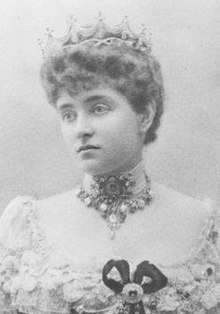Victoria Sackville-West, Baroness Sackville
| The Lady Sackville | |
|---|---|
 Circa 1885 | |
| Born |
Victoria Josefa Dolores Catalina Sackville-West 23 September 1862[1] Paris, France |
| Died |
30 January 1936 (aged 73) Roedean, Sussex, England |
| Spouse(s) | Lionel Edward Sackville-West, 3rd Baron Sackville |
| Children | Vita Sackville-West |
| Parent(s) |
Lionel Sackville-West, 2nd Baron Sackville Josefa de la Oliva (née Durán y Ortega) |
Victoria Josefa Dolores Catalina Sackville-West, Baroness Sackville (23 September 1862 – 30 January 1936)[2] married her first cousin Lionel Edward Sackville-West, 3rd Baron Sackville. Their daughter was the writer, poet and gardener Vita Sackville-West. The family lived mainly at Knole House, an estate that had been in the Sackville family for centuries. Victoria, having experienced a controversial life herself, has since been mostly displaced in the public's consciousness by the colourful life of her daughter Vita.
Early life
Victoria was one of seven illegitimate children[3] of the English diplomat Lionel Sackville-West, 2nd Baron Sackville, and a Spanish dancer known by the stage name of "Pepita de Oliva", (Josephine née Durán y Ortega; she was married to Juan Antonio de Oliva). Pepita was referred to as Countess West, though she never divorced her legal husband or married the father of her children. Victoria was, in youth, referred to as Pepita Sackville West, or 'Lolo', a diminutive of her name Dolores. Whilst at convent school in 1881, however, the truth of her origins was revealed, and she was advised to be known as Victoria West.Victoria's siblings included sisters Flora (born 1866), Amalia Marguerite Albertine (born 1868), and Eliza (who died in 1866, the year after her birth ); and brothers Ernest Henry Jean Baptiste (born 1869), Maximiliano (born 1858), and a short-lived brother named Frederic who died, along with their mother, soon after his birth in March 1871.
Victoria was notorious for beginning and dropping various money-making schemes, some intended for supposedly charitable aims, but most for her personal use. Amongst the schemes was one involving the opening of a shop in South Audley Street, London which Victoria wanted to name Knole Guild following a charitable scheme she had started in Kent of that name. Her husband Lord Sackville objected, and it was doubtless pointed out that the shop was for her own pecuniary benefit and not that of a charity. It was, in the end, named Spealls. Victoria was no natural retailer, and roped in the even less-suited Vita, her daughter, to contributing to the store's stocks. It ended in failure, as did many of Victoria's enterprises.
Victoria's life has been largely overshadowed by the high-profile and controversial life of her bisexual daughter, Hon. Victoria (Vita) Sackville-West.
Lady Sackville was a close friend of the sculptor Auguste Rodin; his marble bust of her, dated 1913, is on display at the Rodin Museum.
Houses
Long a friend of the architect Edwin Lutyens, she engaged Lutyens to remodel a house for her at Sussex Square, Brighton[4] [5], She is also attributed with commissioning Lutyens to build other houses, for example White Lodge at Roedean, Brighton and another for her guests at Worthing. She also commissioned Lutyens to remodel two houses in London,[6] at Ebury Square, Belgravia and at Hill Street, Mayfair.
Later life
Increasingly intolerant of her husband's infidelities, which were carried out in plain sight at their home at Knole, Lady Sackville removed herself to a house on the clifftop overlooking Brighton, Sussex called White Lodge. Her daughter claimed in her book Pepita that Victoria's departure followed what to her appeared to be a subtle argument. Lord Sackville, having experienced war service, was, on his return, more active in the management of Knole. He merely told Lady Sackville that she should inform their bailiff if she wished to take any of their workmen away from the duties to which they had been allotted by the bailiff. She was not to interfere in matters otherwise, whereas she clearly felt she was the rightful chatelaine of the ancient property.
While at White Lodge, she indulged in increasingly eccentric schemes, mostly designed to raise funds for her own benefit given her straitened circumstances. She had experienced at least a couple of nervous breakdowns earlier in her life and seems to have declined into a state of litigiousness, perhaps from an increasingly pressing sense of persecution owing to her illegitimacy and lack of belonging. She became notorious for the number of writs she issued, and was even credited with referring to her home as the "Writs Hotel".[7][8]
Notes
- ↑ Mosley, Charles, ed. (2003). Burke's Peerage, Baronetage & Knighthood (107 ed.). Burke's Peerage & Gentry. p. 3457. ISBN 0-9711966-2-1.
- ↑ "Edwardian Hostess: Death of Victoria Lady Sackville". Gloucestershire Echo. 31 January 1936. p. 1. Retrieved 2014-08-06 – via The British Newspaper Archive. (Subscription required (help)).
- ↑ Lethbridge, Lucy (2014-04-27). "The Disinherited review – a fascinating history of the illegitimate children of an aristocratic family". The Guardian. ISSN 0261-3077. Retrieved 2017-07-22.
- ↑ "A tale of Rodin, Lutyens, Lewis Carroll and Louis-Phillippe - it must be Brighton". The Argus. Retrieved 2017-07-22.
- ↑ "Who's Been Living in My House". www.kemptownestatehistories.com. 2015. Retrieved 2017-07-22.
- ↑ Ron Smith (2005). "Edwin Lutyens and his Two Ladies". Wargrave Local History Society. Retrieved 27 January 2013.
- ↑ Sackville-West, Robert, (2014). The disinherited : a story of family, love and betrayal. London: Bloomsbury. p. 273. ISBN 9781408843406. OCLC 909303437.
- ↑ 1892-1962., Sackville-West, V. (Victoria), (1986). Pepita. Hennegan, Alison. London: Virago. p. 266. ISBN 0860687767. OCLC 14132983.
External links
- Works by Victoria Sackville-West at Faded Page (Canada)
- "Chester Arthur and Victoria Sackville", american-presidents.org; accessed 15 April 2014.
- Victoria Sackville-West, Baroness Sackville at Find a Grave
- [1]
- ↑ "Who's Been Living in My House?". Retrieved 22 Jul 2017.